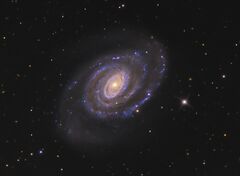Astronomy:NGC 5364
| NGC 5364 | |
|---|---|
 NGC 5364 imaged with the 24-inch telescope at Mount Lemmon Observatory | |
| Observation data (J2000 epoch) | |
| Constellation | Virgo |
| Right ascension | 13h 56m 12.004s[1] |
| Declination | +05° 00′ 52.06″[1] |
| Redshift | 1241 ± 4 km/s[2] |
| Distance | 54.5 ± 3.9 Mly (16.7 ± 1.2 Mpc)[2] |
| Apparent magnitude (V) | 11.2[3] |
| Characteristics | |
| Type | SA(rs)bc pec[4] |
| Apparent size (V) | 6′.1 × 6′.8[5] |
| Other designations | |
| UGC 8853, PGC 49555, ZWG 46.9, IRAS13536+0515[6] | |
NGC 5364 is a grand design spiral galaxy located 54.5[2] million light years away in the constellation Virgo. It is inclined to the line of sight from the Earth at an angle of 47° along a position angle of 25°.[7] It is a member of the NGC 5364 Group of galaxies, itself one of the Virgo III Groups strung out to the east of the Virgo Supercluster of galaxies.[8]
Structure
File:NGC5364 - HST - potw2005a.tif The morphological classification of NGC 5364 in the De Vaucouleurs system is SA(rs)bc pec,[4] which indicates it has an incomplete ring structure (rs) in the inner part of the galaxy with moderate to loosely wound arms (bc) and has a peculiar aspect (pec).[5] In particular, the appearance of the spiral arms is amorphous and asymmetrical compared to other galaxies with a similar classification.[4] A companion galaxy, NGC 5363, is located to the north of NGC 5364 and their gravitational interaction may be influencing the peculiar morphology of the latter.[2]
The mid-infrared emission in the nucleus appears weak compared to the spiral arms, suggesting a low rate of star formation in the core region.[4] The inner ring of this galaxy spans a diameter of 22 kly (6.7 kpc) and is located slightly off center with the northern side showing a stronger emission in the hydrogen alpha band compared to the southern half. Multiple H II regions lie along the spiral arms, tracing out their extent.[2] Each of the two main arms wrap all the way around the galaxy, although they display patchiness along much of their length.[5]
NGC designation
This object was discovered by William Herschel on February 2, 1786, and later listed as NGC 5364. It was subsequently rediscovered by John Herschel on April 7, 1828, and later listed as NGC 5317.[9]
References
- ↑ Jump up to: 1.0 1.1 Skrutskie, Michael F.; Cutri, Roc M.; Stiening, Rae; Weinberg, Martin D.; Schneider, Stephen E.; Carpenter, John M.; Beichman, Charles A.; Capps, Richard W. et al. (1 February 2006). "The Two Micron All Sky Survey (2MASS)". The Astronomical Journal 131 (2): 1163–1183. doi:10.1086/498708. ISSN 0004-6256. Bibcode: 2006AJ....131.1163S. https://ui.adsabs.harvard.edu/abs/2006AJ....131.1163S/abstract.
- ↑ Jump up to: 2.0 2.1 2.2 2.3 2.4 Grouchy, R. D. et al. (June 2010), "Ring Star Formation Rates in Barred and Nonbarred Galaxies", The Astronomical Journal 139 (6): 2465–2493, doi:10.1088/0004-6256/139/6/2465, Bibcode: 2010AJ....139.2465G.
- ↑ "NASA/IPAC Extragalactic Database". Results for NGC 5364. http://nedwww.ipac.caltech.edu/.
- ↑ Jump up to: 4.0 4.1 4.2 4.3 Bendo, George J. et al. (June 2002), "An Infrared Space Observatory Atlas of Bright Spiral Galaxies", The Astronomical Journal 123 (6): 3067–3107, doi:10.1086/340083, Bibcode: 2002AJ....123.3067B.
- ↑ Jump up to: 5.0 5.1 5.2 Buta, Ronald J. et al. (2007), Atlas of Galaxies, Cambridge University Press, pp. 13–17, 216, ISBN 978-0-521-82048-6, https://books.google.com/books?id=g-P7dCbB5MEC&pg=PA16.
- ↑ Revised NGC Data for NGC 5317
- ↑ Kennicutt, R. C. Jr. (December 1981), "The shapes of spiral arms along the Hubble sequence", The Astronomical Journal 86: 1847–1858, doi:10.1086/113064, Bibcode: 1981AJ.....86.1847K.
- ↑ "The Virgo III Groups". Atlas of the Universe. http://www.atlasoftheuniverse.com/galgrps/viriii.html.
- ↑ Seligman, Courtney. "NGC Objects: NGC 5350 - 5399". http://cseligman.com/text/atlas/ngc53a.htm#5364.
External links
- NGC 5364 on WikiSky: DSS2, SDSS, GALEX, IRAS, Hydrogen α, X-Ray, Astrophoto, Sky Map, Articles and images
Coordinates: ![]() 13h 56m 12s, +05° 00′ 52″
13h 56m 12s, +05° 00′ 52″
 |

